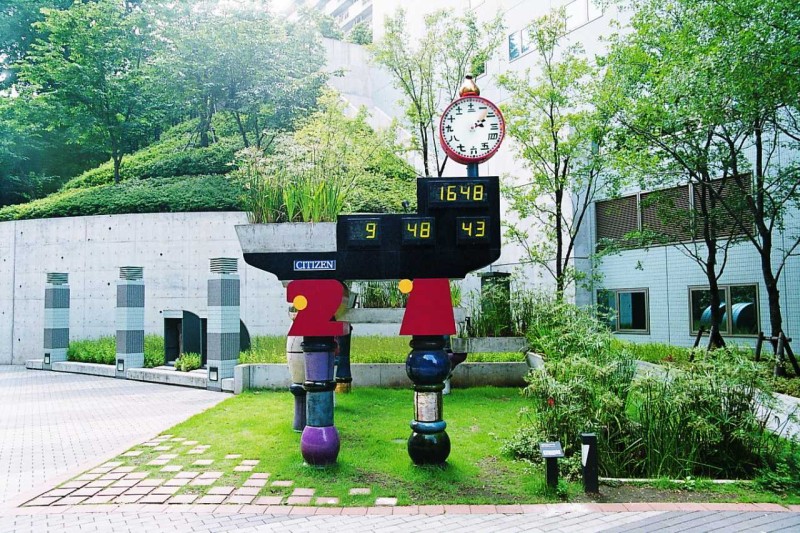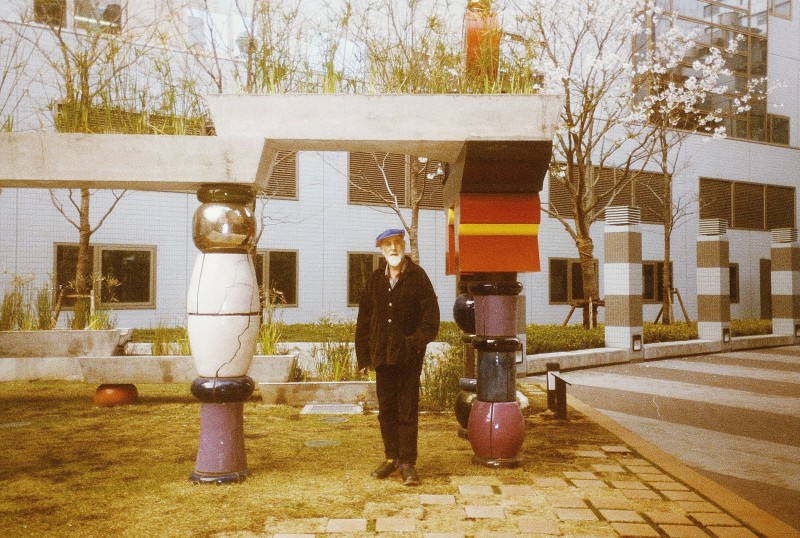Monument for Tokyo Broadcasting System, next to TBS building, Akasaka, Tokyo
Model 1:10, Alfred Schmid, 1992
Installed December, 1992
Designs
I 465 (295) x 602 mm (irregular); Vienna, August 1992
Pencil and watercolour on 3 pieces of paper, glued together
II 298 x 396 mm; Vienna, August 1992
Pencil and watercolour on primed drawing paper
III 298 x 397 mm; Vienna, August 1992
Pencil and watercolour on primed drawing paper
IV 397 x 298 mm; Vienna, August 1992
Pencil and watercolour on primed drawing paper
V Design for colomns
Pencil and watercolour on a copy showing the columns of the model
491 x 296 mm; Klosterneuburg, September 21, 1992
VI Design for the hand of the clock
Watercolour on paper
296 x 210 mm; Klosterneuburg, September 23, 1992
VII Design for the clock face, Japanese figures
Black pen on paper
296 x 210 mm; Klosterneuburg, September 22, 1992
VIII Design for a clock face, roman figures
Black pen on paper
296 x 210 mm; Klosterneuburg, September 23, 1992
Hundertwasser designed the ecological monument for the Tokyo Broadcasting System (TBS) in commemoration of the company's fiftieth anniversary in 2001. The digital display of a Citizen Clock, which could be read from both sides, counted down the days to the anniversary. The monument was erected on the TBS grounds in Midoriyama/Yokohama in December 1992 and moved to Akasaka in 1994.
The accompanying program upon arrival of this event with the theme "Our Beloved Planet, Earth" was focusing on the everchanging Japan, the global environment and mankind.
.
- Contemporary Great Masters: Hundertwasser, Tokyo, 1993, pl. 60 (c), pl. 62 (c), 63 (c), p. 111
- Hundertwasser Architektur, Cologne, 1996, p. 315 (c) and ed. 2006, pp. 298 (c), 309 (c), 313
- P. Restany, Die Macht der Kunst, Hundertwasser - Der Maler-König mit den fünf Häuten, Cologne, 1998, p. 56 (c) and ed. 2018, p. 54 (c)
- R. Schediwy, Hundertwassers Häuser, Vienna, 1999, p. 241
- A. C. Fürst, Hundertwasser 1928-2000, Catalogue Raisonné, Cologne, 2002, Vol. II, pp. 1260/1261 (and c)
- Travelling exhibition 1998/99: Japan, p. 130 (c)



Hundertwasser's comment on the work
This monument is a token, a landmark serving as an ambassador for a peace treaty between men and nature. (...) A consciousness of eternal cycles in harmony with nature and human creation becomes vital, just as timeless constant values, the knowledge of the cosmos where no up and no down exists, no right and no left. It is not the time, which is important but the cycle which develops in organical, beautiful form. Time should create new life, slowly, in spiral form, vegetativ and creative. Time should not destroy past time, should not create last panic before the time of tomorrow. The idea of counting time is a human misleading idea, an invention like the straight line, but there is only eternity developing in an organical cycle. (...)
The same water is permanently flowing through the purification plant. The way of the water through the roots of the plants takes about 1 hour. The roots of these waterplants are producing oxygen and are turning what we call dirt into plant substance. We become witness of a permanent purification and renewal process in harmony with the laws of nature.
Excerpt from Hundertwasser's text of August 1992,
from: Hundertwasser 1928-2000, Catalogue Raisonné, Vol. 2, Taschen, Cologne, 2002, p. 1261